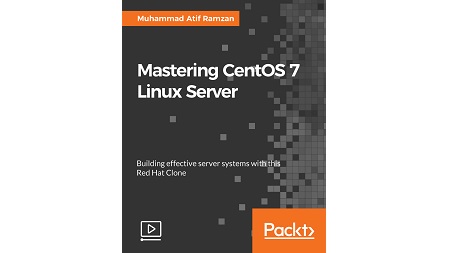
English | MP4 | AVC 1920×1080 | AAC 48KHz 2ch | 3h 37m | 518 MB
Configure and manage CentOS 7 Linux servers to serve a variety of services in a sustainable infrastructure
a brand-new version of the CentOS Linux system in the RPM family and is one of the most widely-used operating systems by many organizations across the World. Most server infrastructures are equipped with at least one Linux server that provides many essential services, both in terms of users and the infrastructure itself.
In this course, you will start by exploring the administration tools of CentOS 7 Linux server and implementing some of the most common Linux services. You’ll get your hands on CentOS 7’s built-in security tool. Next, you will be introduced to the most commonly used services and shown in detail how to implement and deploy a secure and production-grade environment for your organization following the open-source DevOps model. Then, you will start to monitor your infrastructure/server using open-source tools. You will then move on to master virtualization and cloud computing techniques by deploying and configuring IAAS (Infrastructure as a Service). After that, you will work on open-source tools for the configuration and management of multiple nodes. Additionally, you will learn about RAID software-based storage and its advanced configurations.
By the end of this course, you will have learned to monitor servers/infrastructure and master the art of virtualization, cloud computing techniques, configuration management, software-based storage (RAID), and some security tweaks.
Style and Approach
This is a detailed and in-depth guide to help you administer CentOS 7 for use with your server’s infrastructure and also for personal network security. This course will show you a list of tools and utilities you can use to perform the required task, in an easy-to-understand way.
What You Will Learn
- Secure your Centos 7 Linux server
- Use Linux for different purposes
- Configure a mail server with Postfix
- Securely monitor a remote server with Zabbix
- Managing logs using journals
- Configure your virtual machine with virtualization techniques
- Explore cloud computing and configuration management
Table of Contents
Advance User Management
1 The Course Overview
2 Creating, Deleting, and Modify Local User Accounts
3 Changing Password and Setting Password Aging
4 Creating, Deleting, and Modifying Local Groups
5 SetGID on Directories
6 Using Realmd for User Authentication
Security
7 Configuring SELinux
8 Adding and Restoring Security Contexts
9 Configuring SELinux Port Labeling to Allow Services
10 Configuring AIDE for Intrusion Detection
11 Configuring OSSEC for Server Activity
Linux for Different Purposes
12 Implementing DNS Server
13 Setting a Web Server Using Apache-MySQL-PHP
14 Configuring Apache for TLS SSL Certificate
15 Configuring FTP Server with TLS SSL Certificate
16 Remote MySQL Connection
Mail Server with Postfix
17 Exploring Mail Servers
18 Configuring Postfix Email Server
19 Managing Local Email Delivery
20 Email Alias
21 Configuring Remote Email Delivery
22 Securing the Mail Server Using SSL TLS
Monitoring and Logging
23 Open Source Monitoring Tools
24 Configuring Zabbix as a Monitoring Server
25 Configuring Alerts and Triggers
26 Using Journal System for Logging
27 Logrotate
Virtualization
28 Exploring Types of Virtualization and Hypervisor
29 Setting Up VirtualBox Virtualization on CentOS 7
30 Creating a New Virtual Machine
31 Cloning a Virtual Machine
32 Adding Storage to a Virtual Machine
33 Mounting CD-ROM Inside a Virtual Machine
34 Adding and Configuring Network Interface
Cloud Computing
35 Cloud Computing Services
36 Introducing OpenStack and Its Components
37 Installing and Configuring OpenStack Using packstack
38 Quick Demo
Configuration Management
39 Introducing Configuration Management
40 Installation and Configuration of Ansible
41 Running Commands
42 Playbook Structure with YAML
Storage Administration
43 Introduction to RAID and Its Types
44 Preparing Your Software RAID
45 Configuring RAID Device
46 Managing Failover and Recovery of RAID Devices
Resolve the captcha to access the links!